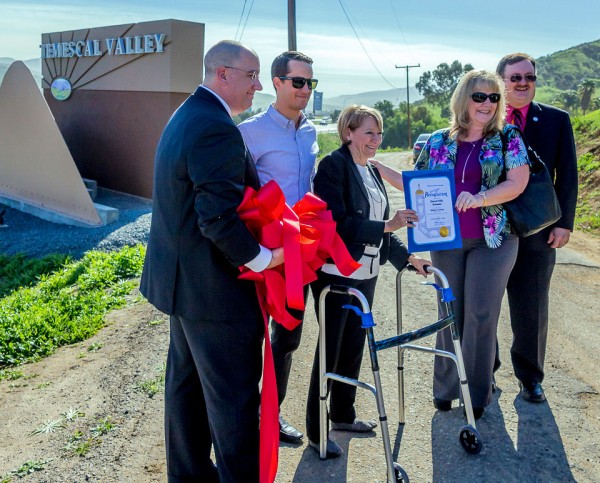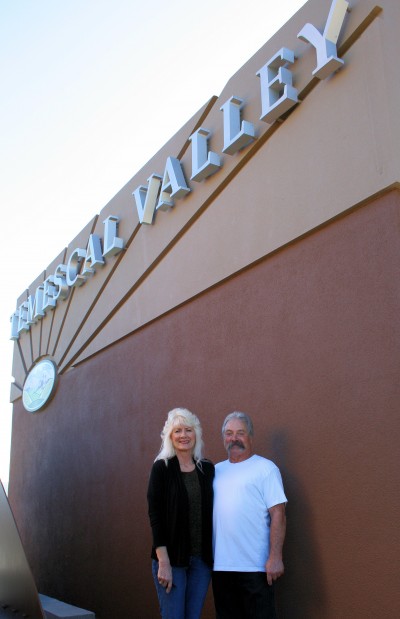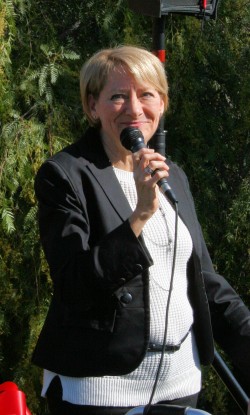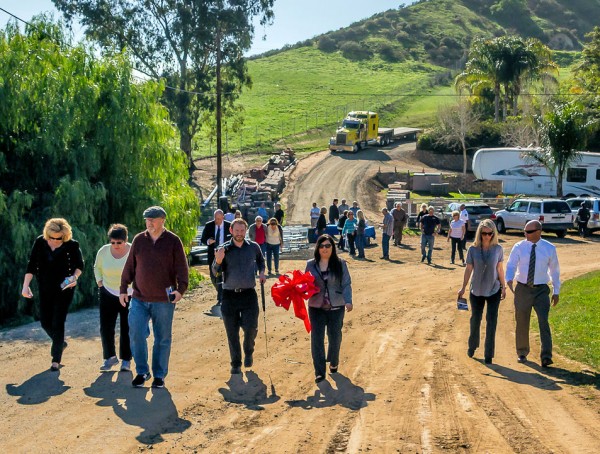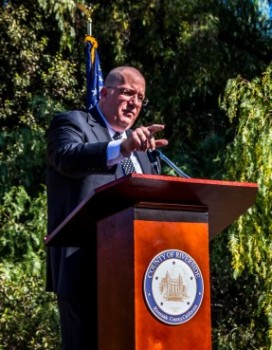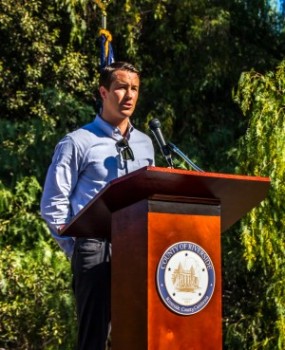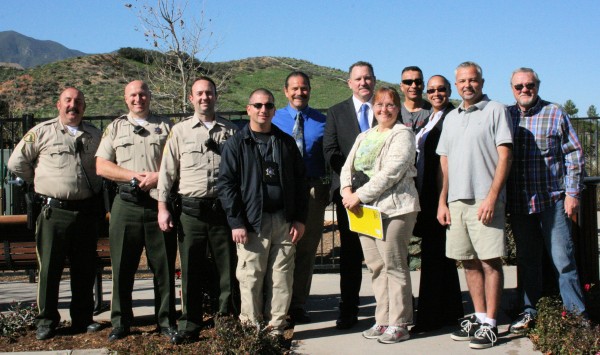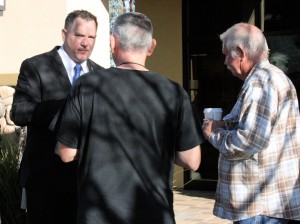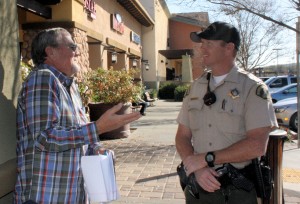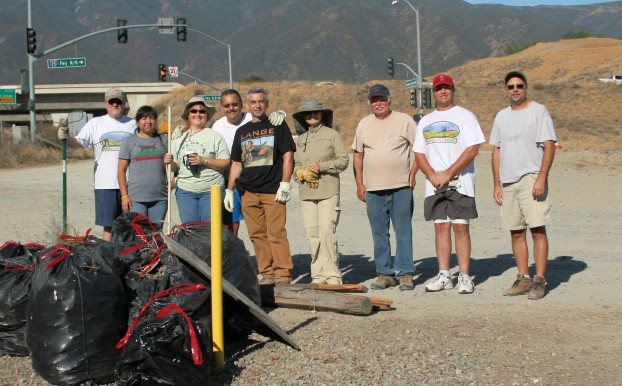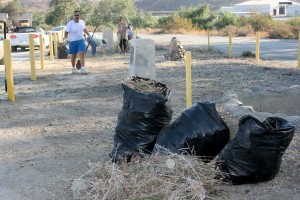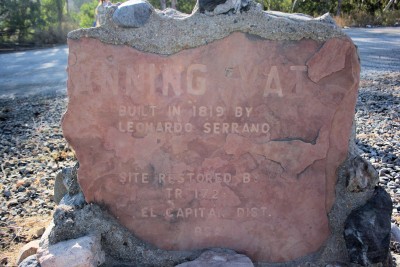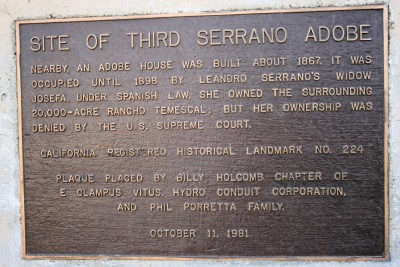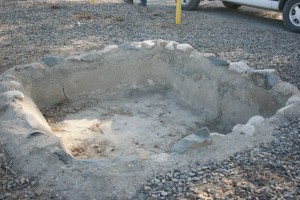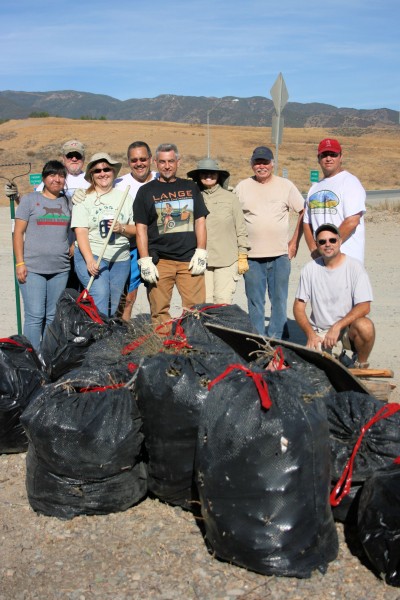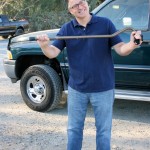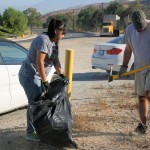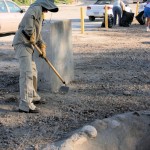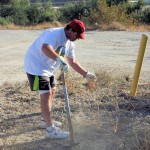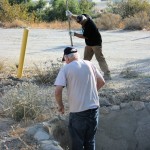Concerns raised by the El Sobrante Landfill Citizens’ Oversight Committee were discussed July 16 during a marathon three-hour-plus meeting at the Lee Lake Water District office.
The purpose of the five-member committee appointed by the Riverside County Board of Supervisors is to review the El Sobrante Annual Monitoring Report and provide comment to the supervisors on the report, including issues or concerns.
Committee members at a meeting held in April questioned the landfill’s appearance, acceptance of incinerator ash, truck traffic on the freeways during peak hours and expansion.
Addressing those concerns at Wednesday’s meeting were General Manager Hans Kernkamp and Principal Planner Ryan Ross – both with the Riverside County Waste Management Department, and Greg Reyes, with the county’s Local Enforcement Agency. The LEA is certified by the California Integrated Waste Management Board to enforce state laws and regulations at solid waste facilities. The landfill, owned by Waste Management, Inc. (WMI), was represented by Mike Williams, district manager.
TRAFFIC CONGESTION
Rob Mucha, chairman of the Citizens’ Oversight Committee (COC), said when the landfill’s hours of operation were expanded in 2009, Waste Management indicated it would ensure that peak hour traffic on SR 91 would not be impacted. He said Temescal Valley residents were told that congestion on local roads would decrease.
Mucha presented a report he compiled based on the county’s traffic numbers that he said shows truck traffic during peak hours is increasing. He said of the 737 weekly trips transfer trucks made to the landfill using the 91 freeway in 2011, 120 trips were between the hours of 6 to 8 a.m. In 2012, 131 of the 706 weekly trips were made between those hours.
Williams said a letter was sent in January to all trash haulers asking that trips not be made during peak traffic hours. Additionally, 60 percent of the trucks using the landfill are Waste Management haulers and those trucks have been equipped with GPS which can be monitored. WMI drivers caught on the 91 during peak times will be warned, fined and could be terminated, Williams said.
COC member Paul Rodriguez suggested that the county determine how “peak hour” was defined in the environmental impact report (EIR), required by the California Environmental Quality Agency (CEQA), when the landfill’s hours of operation were expanded in 2009.
Rodriguez also noted that the statement from WMI to Temescal Valley residents implying traffic congestion on local streets would be reduced was correct. “It was the same number of trucks over a longer period of time, thus reducing congestion,” Rodriguez said.
County representatives responded their attorneys are already attempting to ascertain how CEQA defined “peak hour” in the EIR and that the results would be shared with the COC.
Increasing the price per ton for haulers who continually travel on the 91 during peak hours was suggested by Mucha.
INCINERATOR ASH
Mucha said that when El Sobrante was originally permitted, incinerator ash appeared on a list of excluded items not to be accepted at the landfill, but now is being accepted. He presented a 2012 document from the city of Long Beach Gas & Oil Department to its City Council recommending adoption of a resolution allowing the department to haul incinerator ash to El Sobrante. The ash was being taken to Puente Hills, but with that landfill’s closure in 2013, a new disposal source was being sought. The department also noted El Sobrante was willing to charge the city a negotiated rate below its usual rate for non-county waste.
Williams responded that El Sobrante had been receiving “treated” incinerator ash from Long Beach since November 2013 at a rate of about 450-500 tons a day, and that permits were received a year earlier. He said the city pays the same tonnage rate as other non-county haulers do. He said state law is very strict regarding the acceptance of incinerator ash, requiring that it be treated by a process that renders the toxins inert. An acceptable method is the “wet treatment,” which mixes the ash with cement. Ash treated in this manner is still required to be tested, Williams said, noting that Puente Hills accepted treated incinerator ash for 20 years, using it as a base for roads. “We’re using it as a trash cover, Williams said.
When questioned by COC members why the ash was excluded in earlier permitting, county representatives said that years ago the popular consensus was “to stay away from incinerator ash.”
Kinne asked if incinerator ash was going to county-owned landfills. Both Kernkamp and Ross said treated incinerator ash would be accepted at the county-owned landfills, is not harmful and does not create a hazardous waste stream.
The county is asking the Environmental Health Department to “weigh in” on the issue and asking the county legal department to determine, because incinerated ash in original permits was excluded, is this inconsistency a minor infraction. It was noted that the county could issue a cease and desist order to El Sobrante or update the contract to allow treated incinerator ash at the landfill.
Rodriguez said the county’s report on the issue should contain suggested remedial actions.
LANDFILL APPEARANCE
Mucha questioned whether more could be done to “green up” the front-facing landfill berms which have been hydroseeded but not watered based on the opinion of a WMI biologist that irrigation would produce shallow-rooted, weak plants. Mucha pointed out that the area has been in drought for several years, and a little water to promote growth wouldn’t hurt.
Williams said 3,000 cactuses have been planted and the area flagged for “significant” placement of boulders within the next 30 days pending the approval of the biologist. He said the hydroseed has been checked for viability – it’s good and rain will bring growth.
Mucha presented an opinion he sought from a county ecological specialist that advocated watering because of the drought. Mucha said non-potable water was available for irrigation.
Williams said watering would not only promote the hydroseed’s native plant growth, but weeds as well. He said the problem with the front of the landfill is that it faces south. The north face that was hydroseeded at the same time is green and growing.
Amie Kinne, COC vice chairman, said the former Synagro property that sits at the base of the landfill and currently is owned by WMI, also needs landscape attention.
EXPANSION
Kinne questioned how El Sobrante could build two stormwater retention basins outside the landfill’s footprint. “Dawson Canyon resident Regina Cook’s kitchen window looks out over one of those ponds,” she said.
COC members claim the basins did not receive the necessary permits when El Sobrante relocated them from within the landfill’s footprint to outside of it.
Williams has said the ponds are on property that allows for that type of usage outside the footprint. He was quoted in a story which was published April 17 on The Press-Enterprise website, that the ponds were approved by the Santa Ana Regional Water Quality Control board. That agency told The Press-Enterprise reporter only the ponds’ designs, not location, were approved. (Read the PE story HERE)
The issue now is being investigated by county, state and federal agencies including the county’s Department of Environmental Heath, the U.S. Army Corps of Engineers and both California and U.S. Fish and Wildlife Service.
Kinne questioned if permitting was necessary, would the public have the opportunity to comment. “Who looks after the residents,” she asked.
Cook, who attended the meeting, said she feels “pushed aside” and asked the landfill to “buy my property.” She said she lived in Dawson Canyon years before the landfill was approved, having paid $145,000 for her home. “What’s it worth now — $45,000?” She said the least El Sobrante should do is pay to have her well water tested now that the basin is adjacent to her property. She also asked about vermin control, saying she found a “really big thing” in her back yard – gesturing with her hands, “a rat the size of a raccoon.”
Committee members were concerned that the county, as the lead agency, has no process in place to notify Dawson Canyon residents of changes being made at the landfill.
Kinne, who lives in Dawson Canyon, said she had requested updates from the county but was told she couldn’t have them because she was a COC member. Kernkamp said that would be corrected.
It also was noted that while the regulatory agencies could do a better job communicating with the residents, the agencies needed better communication with each other.
ADMINISTRATIVE REVIEW COMMITTEE
Ross explained the county’s process in preparing El Sobrante’s Annual Monitoring Report. After WMI prepares the report, it’s given to the county’s Waste Management Department for review and comments, and then passed on to the county’s Administrative Review Committee (ARC). That committee includes Ross, who represents the Waste Management Department, and a representative from the county’s Executive Office and Planning Department. The report goes back and forth between WMI, county waste management and ARC, where comments are added, and then eventually is given to the COC. At this point, the COC receives the Annual Monitoring Report which also includes a status report on mitigation monitoring and a conditions of approval compliance report. (View the 2012 report HERE)
COC members wanted to know when they will receive the 2013 report. Earlier in the meeting, Ross mentioned the county is investigating a possible violation of the Brown Act, the state’s open-meeting law. No one elaborated on the possible violation, but Ross said the 2013 report has been delayed because of the investigation.
Ross was asked when the ARC meets to provide its input for the report. Ross said ARC members do not meet face-to-face but email each other instead.
LOCAL ENFORCEMENT AGENCY
Reyes said the LEA works with the state’s water and air boards to enforce laws governing landfills. He said unannounced inspections are held at El Sobrante at least once a month. “We get very few complaints about El Sobrante and it is one of the better landfills,” Reyes said.
When asked about specific complaints, he said they are usually about the trash trucks littering the I-15. “We call El Sobrante and they respond immediately.”
In her closing comments Kinne said, “We must realize this landfill isn’t for 15, 20 or 30 years. It will exist forever.”
The COC will next meet in October to begin review of the 2013 report.
